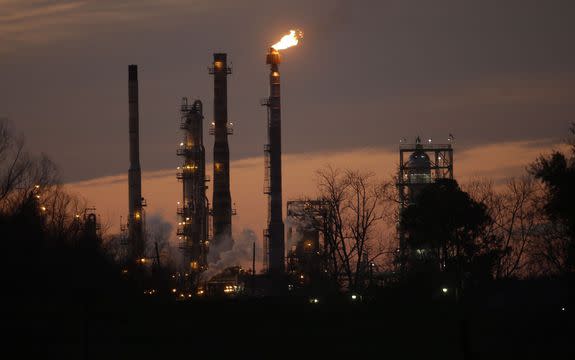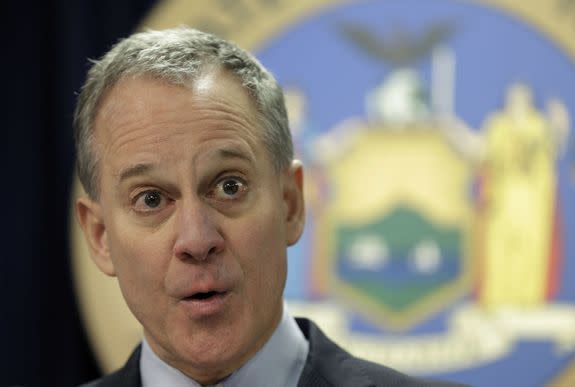Exxon played us all on global warming, new study shows

Every Thursday between 1972 and 2001, the oil and gas giant Exxon Mobil Corp. ran an advertorial in the New York Times.
When these ads — which were aimed at swaying public opinion and appeared in other publications as well — covered the science and policy debate surrounded global warming, they emphasized the uncertainty of the science and the difficulty of solving the problem, if it existed at all.
Yet at the same time, inside the company, Exxon Mobil's own scientists and officials were taking the threat of climate change seriously and viewed it as a potential roadblock to its business.
SEE ALSO: Nuclear war with North Korea 'would be suicidal', climate experts warn
A new study published on Wednesday adds to what we know about Exxon Mobil's "say one thing, research another" approach to the climate issue, which has put the company in legal jeopardy.
The first-ever peer-reviewed analysis of Exxon's private and public climate communications, published in the journal Environmental Research Letters, found that Exxon followed a public relations strategy of sowing doubt regarding climate science findings while quietly hewing to mainstream scientific conclusions internally.

Image: Herbert/AP/REX/Shutterstock
The study is the first to classify the positions taken in Exxon's internal documents as well as its public statements on climate change, and it bolsters the recent work of investigative journalists at Inside Climate News, the Columbia Journalism School, and Los Angeles Times.
"Our study is the first peer-reviewed, academic analysis of Exxon’s 40-year history of climate change communications," said co-author Geoffrey Supran, a science history postdoc at Harvard University, in an email.
"Our results show that Exxon has misled the public about climate change. It did so, we have shown, by contributing quietly to climate science and loudly to raising doubts about it."
The research is likely to play into investigations by multiple state attorneys general, aimed at determining whether Exxon Mobil purposefully misled the public and shareholders about the reality and seriousness of global warming. Such activities may have violated multiple statutes.
The Securities and Exchange Commission has initiated a separate but similar investigation regarding the company's disclosure of investment risks. Together, these investigations are known on social media by the hashtag, #ExxonKnew.
The new study, by Supran and the well-known science historian Naomi Oreskes, could bolster the legal cases currently being explored, though it is not explicitly aimed at making any legal judgements, the authors state.
Supran and Oreskes chose to undertake this study in part because of how Exxon Mobil has sought to defend itself from the allegations. The company has published a list of more than 50 peer-reviewed articles on climate research and policy from 1983 to the present day, and denied that it "suppressed climate change research."

Image: Seth Wenig/AP/REX/Shutterstock
The company has also made some internal documents public in the wake of the investigative reporting during the past two years.
"Read all of these documents and make up your own mind," the company has said.
So, Supran and Oreskes did just that, approaching it from an academic perspective so they could classify each document's position on whether human-caused climate change is real, a serious threat, and solvable.
The analysis of 187 documents found a consistent discrepancy between the company's public and private communications about climate change. The external documents focused on doubt about climate science, while internal communications acknowledged the risks of human-caused global warming.
Notably, the researchers found that ExxonMobil's scientists were aligned with mainstream climate experts in acknowledging human-caused climate change as real and human-caused, and even projected more significant global warming than other assessments in the peer-reviewed scientific literature.
"On the question of whether ExxonMobil misled non-scientific audiences about climate change, our analysis supports the conclusions that it did," the study states.
"Exxon Mobil contributed to climate science — by way of its scientists’ academic publications — but promoted doubt about it in public, through advertorials," Oreskes said.
Climate deniers have spent years criticizing Oreskes' previous work that quantified the agreement within the scientific community on global warming, and she and Supran are ready for whatever Exxon throws their way this time.

Image: Bob Al-Greene/Mashable
"Exxon may say that these are just our opinions, but they’re not — these are our evidence-based conclusions, which have passed the peer-reviewed scrutiny of anonymous experts in the field. Our methods and evidence are transparent and audit-able," Supran said.
Interestingly, the study found that the company is also paying acute attention to the potential problem of stranded fossil fuel assets. Right now, the company assumes that its massive fossil fuel reserves will be burned to generate electricity and power cars and trucks. However, if world leaders enact limits on carbon emissions that prohibit the burning of Exxon Mobil's reserves, presumably the company's value would tumble.
This topic is of particular interest to company shareholders and financial regulators.
"... We found that Exxon discussed the topic of stranded fossil fuel assets in no less than 24 documents, but never in advertorials," Supran said in an email.
"To me it’s noteworthy that Exxon didn't just vaguely or qualitatively refer to this risk. In at least five cases, they actually quantified how much carbon dioxide we can afford to burn before we blow the 2-degree Celsius [or 3.6 degrees Fahrenheit] guardrail. And they were accurate — within a factor of two of contemporary estimates," he said.
"This may be relevant to ongoing investigations into whether Exxon has properly disclosed the risks of its assets becoming stranded by climate policy."
ExxonMobil did not respond to a request for comment about this study.
WATCH: The most epic images from the 2017 total solar eclipse


